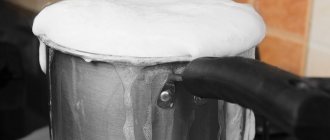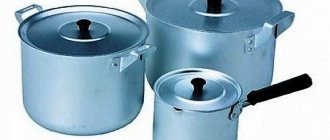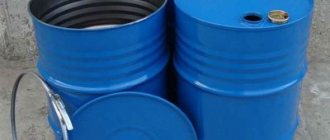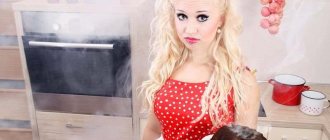Many housewives are faced with a situation where the shiny surface of a pot or frying pan becomes covered with dark soot, which cannot be cleaned off with regular dishwashing detergent. If the slightest manifestation of such contamination is detected, it is necessary to get rid of it immediately. Otherwise, burnt particles may fall off, get into food and negatively affect the human body. How to clean the burnt bottom of a pan? The most important thing is to choose the right effective cleaning agent that will not harm the metal.
What to clean: sponges, foil, tablets
To clean a burnt pan, you will have to make physical efforts. You will need to rub - this is the main method of cleaning. All other means are needed to speed up or facilitate the process. But the main thing is the mechanical removal of burnt material. For cleansing we use:
- Kitchen sponges made of foam rubber with varying degrees of hardness.
- Metal jaws.
Foam rubber and metal sponges are what you will need.
It’s better to start with the softest option, if it doesn’t work, go to a harder “equipment”. It is better not to rub some types of dishes with metal sponges at all. These include polished stainless steel cookware and non-stick coatings. Any scratch on them is a disaster: the pots and pans will have to be thrown away.
There is another amazing method. You can clean burnt parts with foil crumpled into a ball. Believe it or not, it scrubs better than metal sponges and leaves no scratches.
Regular baking foil does a good job of scraping burnt marks from the bottom of a pot or pan without scratching the dishes.
Another way to use conventional means in a non-standard way. A dry dishwasher tablet can be used instead of a scraper. But it is very caustic, so only hold it with gloves.
The dishwasher tablet itself is a good scraper. The substances contained in it will simultaneously corrode burnt food residues
Pour a little water into the bottom of the pan (about 1 cm at the bottom) and heat over low heat. Remove from the burner and rub the black spot under water with this “scraper”. If you like, add a couple drops of dishwashing liquid or baking soda.
Causes of food burning
Often food burns due to carelessness. The housewife gets distracted and forgets that there is a saucepan on the burning stove, the liquid evaporates, and the food settles in a dense burnt crust at the bottom of the container.
Food sticks even to modern Teflon coatings. This is primarily due to the long service life, since over time, scratches and microcracks appear on the surface, which become the main cause of food burning.
Damage occurs over time on both aluminum and cast iron pans. In this case, not only the process of preparing dishes causes inconvenience, but also the subsequent washing of the dishes - it is very difficult to wash them.
Burns form in the pan even when it is left empty on the burner. This is also affected by temperature changes.
Traditional methods and “improvised” means for cleaning pots
Burnt pans of any type can be cleaned with baking soda or salt. Just pour 50-100 grams, add water to cover the burnt 3-5 cm on top and boil for 15 minutes. Then rub.
Soda and salt - the first thing you can try
What should I use, salt or baking soda? Try one at a time. In some cases, baking soda works better, in others, salt. Burnt food (porridge, jam, sugar and other products) comes off. Not immediately and not quickly, but it clears up. After the blackness almost stops coming off, boil again with one of the components.
Sometimes it's easier to clean if you sprinkle baking soda on the bottom of the dish. Generously. Then add a little water and leave for several hours. After this soaking, burnt food can be easily wiped off.
Burnt stainless pans can also be cleaned with a soda solution, but it will be faster if the soda is replaced with Pemolux. Everything else is the same - add water, boil for 20 minutes.
Instead of regular soda, it is more effective to use Pemolux abrasive powder
The peculiarity is that it must be cleaned immediately after boiling - it comes off easier. And you can’t use a metal sponge - it will leave scratches. You will have to rub with the hard side of a foam kitchen sponge.
We use soda or Pemolux
Some types of deposits can be removed from a stainless pan by pouring vinegar and leaving for several hours (even overnight or for a day). The same trick will work with intact enamel, but it is better not to test the strength of cast iron, aluminum or non-stick coatings in this way.
You can use lemon instead of vinegar. Cut it into slices, add water, boil for about 10 minutes and leave the solution in the bowl. Then rub until the blackness goes away.
How to wash caramel from a pan
Caramel that clings to the surface of pans is nothing more than burnt sugar. Therefore, the methods for getting rid of it are similar to those described in the section on washing pans from burnt jam. Ridding them of this pollution seems to be a very difficult task, but quite solvable.
You can use the following tools:
- the Teflon coating easily separates from the caramel, you just need to fill it with a large amount of water with the addition of a detergent, and then rinse thoroughly;
- An aluminum surface can be washed by using boiling silicate glue in combination with laundry soap and citric acid or soda, and polishing the surface with a few drops of ammonia will also help.
Cleaning burnt pots using kitchen chemicals
For emergency cleaning of burnt marks on pots, you can use kitchen cleaners. For example, for cleaning the grill, oven, glass-ceramic stove. There is only one way - apply, wait, wash and rub. Before cooking food in a cleaned pan for the first time, boil clean water a couple of times.
If the pan looks like this, it’s no longer the same as using
You can also fill a dishwasher tablet with water and boil it. While the pan is warm, even burnt fat and vegetable residues come off well. To prevent the dishes from cooling down longer, do not rush to pour out the solution. Rub in water. When there is too much leftover residue, pour it out and scrub while warm.
Cleaning Features of Non-Stick Coating
In order to clean such a pan, you should use only gentle methods. The use of folk remedies is encouraged, since they are more environmentally friendly and safer for Teflon:
- laundry soap;
- soda;
- salt;
- PVA glue.
When cooking, it is recommended to use spatulas made of plastic, silicone or wood. To prevent the formation of carbon deposits, it is important to wash the dishes every time after use, otherwise the frozen fat will settle tightly on the surface and may burn during subsequent use.
Before you clean the pan from carbon deposits, it is important to understand what material it is made of. Metals react differently to cleaning compounds, and dishes can be damaged beyond repair. A burnt pan can be cleaned with both professional household chemicals and solutions prepared at home.
Rate this post
Not for dishwashing detergents, but they do clean burnt-on pans
You can also clean burnt marks from dishes using chemicals that do not apply to the kitchen:
- Try AHE Active Stain Remover Powder. Pour into the bottom, add a little water and leave for several hours. Then use a metal sponge or the back of a foam kitchen sponge (if you don't want any scratches).
- Cleansing cream CIF. Just pour it over the burnt remains and wait.
All-purpose cleaners can also be used - Auto chemical goods. More precisely - means for washing injectors. But this product is only for stainless pans.
Some housewives use acidic sanitary ceramic cleaners to clean burnt dishes. They work. And quickly. But how safe it is to use “toilet” products for pots is a question.
You can also use dryer sheets. These are pieces of non-woven material impregnated with some means. They are placed in an automatic clothes dryer. Place such a napkin on the bottom of the pan, pour a little water. Just make sure the bottom is covered. Leave it in this form for 8-12 hours, and then rub it. It is not clear what kind of substances are contained in the napkin, but the burnt residues come off in one or two minutes.
Drying cloths - great for cleaning burnt-on pots
The video below demonstrates another working “non-kitchen” product - washing gel. It can be diluted with water and boiled for 20 minutes in a saucepan. It couldn't be done without a scraper, but even a strong burn was removed.
Milk serum
Suitable for materials: aluminum, enamel, ceramics, cast iron, stainless steel.
Type of burnt product: milk, jam, sugar, porridge.
Instructions:
- Fill the pan with whey until it covers the soot.
- Let stand for 24 hours.
- Drain off the whey and remove any remaining carbon deposits using traditional detergents.
It is not advisable to wash ceramic pots and pans using harsh abrasive products - they will scratch the surface, causing the food in such dishes to burn.
Safe, gentle cleaning with products
Let's talk about less extreme ways using products. Or rather, the substances they contain. The simplest is to pour in Coca-Cola and leave for a while. This drink is said to cleanse everything. It works well to remove burnt milk and milk porridges.
Coca-Cola and ketchup also help clean burnt dishes
Another option is to pour baking soda into a saucepan, then pour in Coca-Cola and leave for an hour. There is an effect both ways, but the second method is faster. You can also try to clean the burnt material from the bottom of the pan using:
- Ground grapefruit mixed with baking soda. Grind a whole grapefruit with peel (in a blender) and add a few tablespoons of soda to make a porridge. Apply it to the bottom and wait about an hour.
- Grated potatoes with soda. Grate the potatoes on a fine grater, mix with soda and apply the paste onto the black spot on the bottom.
Even potatoes can work - Ketchup. We simply pour it into the pan, making sure that the burnt areas are well covered. We wait an hour and scrape off the blackness.
- A mixture of soda and ammonia. Mix the porridge from these components in a glass or stainless bowl (breathe away from the bowl, as the smell is pungent). Apply, close the lid and wait 30 minutes.
It cannot be said that all these methods work equally effectively. Sometimes they really clean quickly and immediately, sometimes they help soften what’s burnt on it. But this is not a panacea. But it is unlikely that they will damage the dishes.
How to clean a pan from yellow deposits
You can get rid of yellowness on the pan using coffee grounds.
The yellowish soot that forms on the surface of pots as a result of not washing them too thoroughly can ruin the appearance of the most expensive set of dishes. To prevent this situation, it is advisable to clean the dishes at least once a week using a mild abrasive agent suitable for this type of container.
In addition, the following home remedies work well with yellow plaque:
- cleaning the walls of dishes with coffee grounds;
- a frying pan soaked in vinegar can be easily and quickly cleaned of yellowness;
- the composition “Persol”, boiled in a saucepan, is considered the optimal method of cleansing;
- 1/2 tablespoon of citric acid can quickly remove yellow plaque;
- you can add “Whiteness”, which you use to wash your plumbing fixtures; it also works well with kitchen utensils, although it requires careful rinsing of the dishes.
A housewife who does not want her dishes to become covered with a yellow coating will promptly clean them from household contaminants and dry them thoroughly, putting them away for storage.
How to bring dishes back to their “pristine” form
In enamel pans, after removing burnt residue, dark spots remain. If they don't bother you too much, just use the utensils. After some time the color returns to normal.
If you want to get rid of dark spots, try boiling a dishwasher tablet. For white or very light enamel, whiteness works well. But this is not a safe remedy. So after the color is restored, boil clean water several times.
After severe overheating, stainless steel may change color in places. There are no options anymore. Just use the utensils. It is impossible to remove these stains: some of the alloying substances have evaporated, and this is irreversible.
Reasons for the appearance of soot on the walls and bottom of the pan
If we exclude the most common cause of a burnt pan, it is leaving cooking dinner on the stove unattended, and the water simply boiled away and the food burned. An important factor is the quality of the cookware and its proper use. Yellow plaque and scale from hard water, and when the coating is painted in different colors: from bright berries, fruits and vegetables.
Caring for dishes involves daily high-quality cleaning.
Stainless steel, enameled, aluminum, cast iron pots - what are the differences when cleaning
The good thing about stainless steel cookware is that it is difficult to spoil. It tolerates any chemicals without consequences. How can it be damaged? Scratch. Based on this, choose cleaning methods. That is, take any means, but do not use hard scrapers and “cleaners” with large abrasive particles.
Cleaning may damage the dishes
Polished stainless steel can be scratched even with the hard side of a kitchen sponge. I wash it exclusively with active substances in the form of liquids, gels or sprays. You can clean such utensils only with rags or sponges.
Aluminum cookware, on the contrary, actively reacts. It cannot be treated with active acids. But for cleaning you can use metal sponges and abrasives.
Cast iron cookware is now quite rare. If there is, then its walls are usually covered with enamel or non-stick coatings. Cleaning products are selected based on the coating.
You can try cleaning products for cast iron or frying pans
If you have old cast iron pots or cauldrons, they can be cleaned by any means and even with hard scrapers. But if they already have cavities, it is impossible to “extract” the burnt from them. It is often recommended to sandblast burnt cast iron cookware. After cleaning, the cauldrons look great, but they get dirty very quickly. The fact is that grains of sand leave microscratches in which soot, grease, and food debris accumulate. There is a way out - polish it to a shine using a rag. But it's long and tedious. Easier to clean without sandblasting. All by the same means described above.
How and with what can you clean enamel pans? If there are no enamel chips, then almost everything we use for the kitchen. Any means, metal sponges, the hard side of foam sponges. If there are already large areas without enamel, it is better not to use active acids, otherwise a hole will quickly appear.
Tips for proper cleaning without damaging dishes
By following the manufacturer's recommendations for caring for cookware, and a few expert tips, your saucepan will serve you for many years.
It should be remembered that the use of compounds with a complex chemical formula requires the mandatory use of gloves and compliance with safety precautions.
- Buy cookware with a non-stick coating, which will save you a lot of cleaning work.
- If trouble happens and the pan burns, do not leave it for a long time. It is better to scrape out the contents and soak immediately with water and detergent, then further cleaning will be easier and more effective.
- It is better to use traditional cleaning methods, they are safer and just as effective.
It is advisable to clean pots in well-ventilated areas.
Any trouble in the kitchen can be fixed, the main thing is to know how to deal with it. And then your dishes will delight you with their cleanliness for a long time, and your loved ones with delicious dinners.
PVA glue and laundry soap
Suitable for materials: aluminum, enamel, ceramics, cast iron, stainless steel.
See also: How to replace corn syrup + simple homemade recipe
Type of product: porridge, milk.
Instructions:
- Grate 100 gr. laundry soap on a coarse grater.
- Take water, add crushed soap.
- Add PVA glue in a proportion of 100 ml per 1 liter of water.
- Boil for 2-3 hours.
- Cool and remove any remaining carbon deposits.
This method works well for old black spots.
Soda-salt mixture
Suitable for materials: cast iron, enamel.
Type of soot: porridge, sugar, pasta, milk, jam.
Instructions:
- In a separate container, mix 2 tbsp. spoons of table salt, baking soda and 100 ml of water.
- Apply the resulting mixture to dirty areas, cover with a lid and let sit for 24 hours.
- Rinse off the soda-salt mixture and add water.
- Boil for 0.5 hours.
- Allow to cool, rinse with traditional means.
Washing a badly burnt enamel pan - video
Choose a frying pan on which nothing burns
- Cast iron will prevent burning due to thick walls that distribute heat. Its only drawback is its heavy weight.
- Aluminum - must have a wall thickness of at least 5 mm, otherwise the food will burn. It is better to choose cast pans rather than stamped ones. The frying pan must have a non-stick coating.
- With Teflon coating they avoid burning, but require very careful care. When cooking, you should avoid metal spatulas, and also do not clean such a frying pan with abrasive products.
- Titanium frying pans have the positive qualities of cast iron. Their only drawback is their high price.
- The surface of ceramic frying pans is non-stick. But unscrupulous sellers can pass off a thin layer of enamel as ceramic; you need to be careful when choosing.
There should be no chips, cracks, or scratches - this will lead to food burning in these areas.
Modern chemicals to combat carbon deposits
You can find many modern, effective cleaning products on the shelves of hardware stores. Most often, they are universal, suitable for cleaning any dirt from any dishes. But in order to avoid mistakes and not spoil Teflon or stainless steel, you need to read the instructions on the packaging and find out what kind of cookware the product is suitable for.
Among the general purpose chemicals:
- aggressive preparation Shumanit (for cleaning baking sheets, frying pans, pots and other utensils);
- cleaning products from the Amway product line;
- Sanita gels and powders;
- Sarma dishwashing and cleaning products.
Fairy, Sorti, AOS and other common brands of dishwashing gels are also suitable for removing not too strong deposits.











